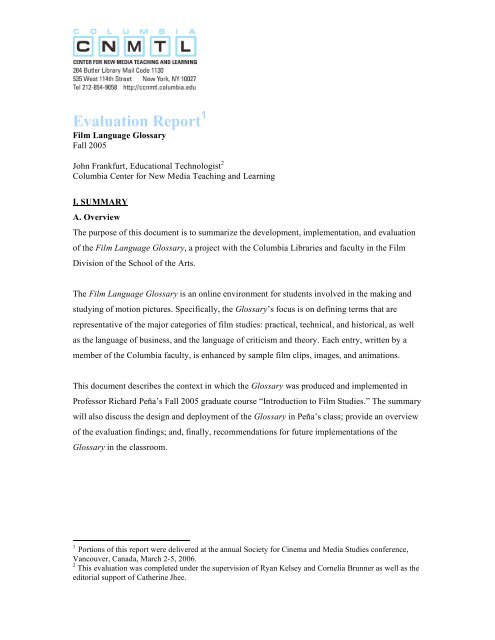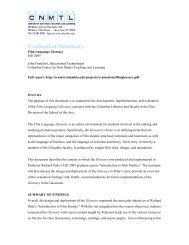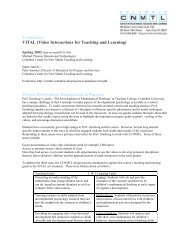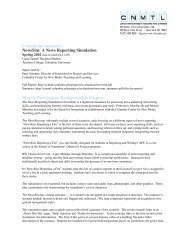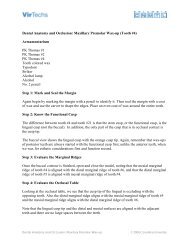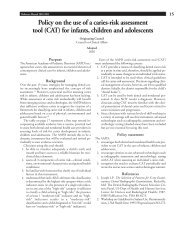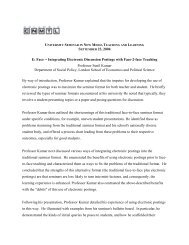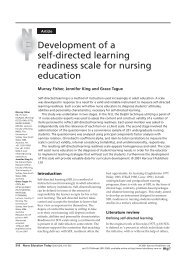Evaluation: Film Language Glossary - Columbia Center for New ...
Evaluation: Film Language Glossary - Columbia Center for New ...
Evaluation: Film Language Glossary - Columbia Center for New ...
Create successful ePaper yourself
Turn your PDF publications into a flip-book with our unique Google optimized e-Paper software.
<strong>Evaluation</strong> Report 1<br />
<strong>Film</strong> <strong>Language</strong> <strong>Glossary</strong><br />
Fall 2005<br />
John Frankfurt, Educational Technologist 2<br />
<strong>Columbia</strong> <strong>Center</strong> <strong>for</strong> <strong>New</strong> Media Teaching and Learning<br />
I. SUMMARY<br />
A. Overview<br />
The purpose of this document is to summarize the development, implementation, and evaluation<br />
of the <strong>Film</strong> <strong>Language</strong> <strong>Glossary</strong>, a project with the <strong>Columbia</strong> Libraries and faculty in the <strong>Film</strong><br />
Division of the School of the Arts.<br />
The <strong>Film</strong> <strong>Language</strong> <strong>Glossary</strong> is an online environment <strong>for</strong> students involved in the making and<br />
studying of motion pictures. Specifically, the <strong>Glossary</strong>’s focus is on defining terms that are<br />
representative of the major categories of film studies: practical, technical, and historical, as well<br />
as the language of business, and the language of criticism and theory. Each entry, written by a<br />
member of the <strong>Columbia</strong> faculty, is enhanced by sample film clips, images, and animations.<br />
This document describes the context in which the <strong>Glossary</strong> was produced and implemented in<br />
Professor Richard Peña’s Fall 2005 graduate course “Introduction to <strong>Film</strong> Studies.” The summary<br />
will also discuss the design and deployment of the <strong>Glossary</strong> in Peña’s class; provide an overview<br />
of the evaluation findings; and, finally, recommendations <strong>for</strong> future implementations of the<br />
<strong>Glossary</strong> in the classroom.<br />
1<br />
Portions of this report were delivered at the annual Society <strong>for</strong> Cinema and Media Studies conference,<br />
Vancouver, Canada, March 2-5, 2006.<br />
2<br />
This evaluation was completed under the supervision of Ryan Kelsey and Cornelia Brunner as well as the<br />
editorial support of Catherine Jhee.
B. SUMMARY OF FINDINGS<br />
Overall, the design and deployment of the <strong>Glossary</strong> supported the curricular objectives of Richard<br />
Peña’s “Introduction to <strong>Film</strong> Studies.” With the site integrated into the course objectives, students<br />
connected the <strong>Glossary</strong> with course content taught by Peña and made use of the various resources<br />
on the site <strong>for</strong> class discussions, screenings, readings, and course papers. Cross-referencing terms<br />
improved students’ abilities to rein<strong>for</strong>ce and recognize the various connections that exist among<br />
the film terms covered by Peña. In addition, video clips that include faculty commentary and<br />
graphic annotations further supported the students' understanding of a term and how it applies<br />
across various films. The <strong>Glossary</strong> should continue to be offered and developed as a pedagogical<br />
tool in Peña’s introductory class.<br />
It is difficult to determine whether the implementation of the <strong>Glossary</strong> in classes other than<br />
Peña’s helped achieve the pedagogical goals of these courses. Data is mixed as far as which site<br />
elements were helpful and which were not in classes other than Peña’s as these courses tended to<br />
use the <strong>Glossary</strong> only as a general resource and did not to recognize any intellectual architecture<br />
of the site. The architecture of the <strong>Glossary</strong> was based on Peña's methodology of teaching film<br />
vocabulary, but not in a manner that would <strong>for</strong>ce a user to go through the site exactly as it is<br />
taught in Peña’s introductory class. By implementing the <strong>Film</strong> <strong>Language</strong> <strong>Glossary</strong> as an active<br />
classroom tool, as opposed to a general resource, we begin to indicate how we might redefine our<br />
understanding of digital glossaries in education. In order to meet the long-term goal of making the<br />
<strong>Film</strong> <strong>Language</strong> <strong>Glossary</strong> an extensive learning tool that can be repurposed <strong>for</strong> many courses, in<br />
the <strong>Film</strong> Division and beyond, continued strategies <strong>for</strong> rein<strong>for</strong>cing class expectations and<br />
supporting student interaction are recommended <strong>for</strong> the direct integration and subsequent<br />
evaluation of the <strong>Glossary</strong>.<br />
II. INTRODUCTION: The <strong>Film</strong> <strong>Language</strong> <strong>Glossary</strong><br />
A. PROJECT DESCRIPTION<br />
The <strong>Film</strong> <strong>Language</strong> <strong>Glossary</strong> is intended <strong>for</strong> students involved in the production and study of<br />
motion pictures. Its focus is on defining film terms and film language, and it is analogous to the<br />
Sonic <strong>Glossary</strong>, an environment built by CCNMTL <strong>for</strong> the Music Department, in its purpose as a<br />
2
teaching resource. 3 The <strong>Film</strong> <strong>Language</strong> <strong>Glossary</strong> does <strong>for</strong> the moving image and the art of<br />
filmmaking what the Sonic <strong>Glossary</strong> does <strong>for</strong> sound and music.<br />
The <strong>Film</strong> <strong>Language</strong> <strong>Glossary</strong> defines essential terms used in basic and advanced film courses. It<br />
does not replace classroom teaching; rather, the <strong>Film</strong> <strong>Language</strong> <strong>Glossary</strong> is an instrument that<br />
enhances screenings, readings, lectures, and discussions throughout the duration of a course.<br />
Students there<strong>for</strong>e develop a more thorough lexicon of film vocabulary, <strong>for</strong> their own needs or as<br />
required by a course. Furthermore, professors are able to make more dynamic in-class<br />
illustrations and spend less time covering terminology.<br />
The <strong>Glossary</strong> is used primarily by the <strong>Columbia</strong> University community. 4 The first course that this<br />
resource was designed <strong>for</strong> and implemented in is Richard Peña’s “Introduction to <strong>Film</strong> Studies.”<br />
Other film studies courses that have since made use of this resource include “Introduction to <strong>Film</strong><br />
Studies” (undergraduate); “Practical <strong>Film</strong> Analysis,” “Topics in World Cinema,” and “Seminar in<br />
<strong>Film</strong> Studies.”<br />
In addition to its implementation in <strong>Film</strong> Division courses, the <strong>Glossary</strong> is also helpful <strong>for</strong><br />
students working in interdisciplinary research with an emphasis on film. Such research is<br />
currently conducted in departments as varied as History, English and Comparative Literature,<br />
American Studies, Political Science and International Affairs, all of which use the Butler Media<br />
Collection and Services and consult with Nancy Friedland regarding collection content and<br />
curricular needs.<br />
To build a glossary that meets the various and changing needs of <strong>Film</strong> Division courses and other<br />
film-related courses at <strong>Columbia</strong>, the environment's design follows an organic production model.<br />
Specifically, the content of the <strong>Glossary</strong> does not need to be produced and uploaded all at once—<br />
doing so would make it difficult to produce in a timely manner; rather, content can be added<br />
periodically, from semester to semester, based on the evaluation results from Peña’s course as<br />
well as on newly identified needs from other faculty using it. The belief is that an organic<br />
glossary has the potential to be self-sustaining—that is, the <strong>Film</strong> Division will eventually be able<br />
3<br />
The Sonic <strong>Glossary</strong>, produced by CCNMTL and Professor Ian Bent, can be found at the following URL:<br />
https://www1.columbia.edu/sec/itc/music/sonic/.<br />
4<br />
The <strong>Glossary</strong>’s project manager, John Frankfurt, implemented The <strong>Film</strong> <strong>Language</strong> <strong>Glossary</strong> in his lecture<br />
course “Practical <strong>Film</strong> Analysis,” at Hunter College, Department of <strong>Film</strong> and Media, in the fall of 2005.<br />
3
to take the lead in managing the site (making additions and changes), with CCNMTL lending<br />
support when necessary.<br />
B. CONTEXT<br />
In Fall 2003, Richard Peña, a professor in the <strong>Film</strong> Division of the School of the Arts (SOA), and<br />
Nancy Friedland, the head of media services and the film-studies librarian at Butler Library,<br />
submitted a project application to CCNTML <strong>for</strong> an online film glossary. The glossary would<br />
serve three purposes. In order of priority, they are:<br />
1) as a tool <strong>for</strong> Peña’s “Introduction to <strong>Film</strong> Studies” course;<br />
2) as a tool to be offered to other <strong>Columbia</strong> faculty teaching film in the <strong>Film</strong> Division and<br />
elsewhere on campus; and, finally,<br />
3) as a library resource available to members of the <strong>Columbia</strong> community.<br />
In Spring 2004, CCNMTL began working with Peña and Friedland to create the <strong>Glossary</strong>. A<br />
prototype of the <strong>Film</strong> <strong>Language</strong> <strong>Glossary</strong> was built by Summer 2004. After a limited deployment<br />
during the fall 2004 semester, the prototype was used as the basis <strong>for</strong> the curricular and functional<br />
specifications documentation produced the following spring semester. Several <strong>Columbia</strong> faculty<br />
members contributed film terms, made clip selections, and added audio commentary to the<br />
<strong>Glossary</strong>. Peña, in addition to his own contributions, served as the executive editor <strong>for</strong> all content<br />
added to the site.<br />
C. HISTORY/JUSTIFICATION<br />
Any group producing a new glossary or dictionary on any subject must be aware of those who<br />
preceded them in the field. And while it is important to acknowledge earlier works both in print<br />
and online, it is even more crucial to specify how a new glossary differs from others.<br />
Print<br />
The <strong>Glossary</strong> of <strong>Film</strong> Terms, compiled by John Mercer and published by the University <strong>Film</strong> and<br />
Video Association, offers an extensive list of film terms, but its definitions are generally limited<br />
to one or two brief sentences. Other books that are extensive yet <strong>for</strong> the most part offer short<br />
definitions include Frank Beaver’s Dictionary of <strong>Film</strong> Terms, Virginia Oakey’s Dictionary of<br />
<strong>Film</strong> and Television Terms, Lynne Naylor Ensign and Robert Knapton’s The Complete<br />
Dictionary of Television and <strong>Film</strong>, and Ralph S. Singleton’s <strong>Film</strong>maker’s Dictionary. It is<br />
4
important to point out the problems inherent in printed glossaries and dictionaries: they tend to be<br />
oversized, expensive, and usually available only on reserve at libraries. The ease and accessibility<br />
of an online film glossary are benefits that cannot be overlooked.<br />
Online<br />
There are a growing number of film glossaries and dictionaries that are available online. Most of<br />
these, however, tend to be entirely textual and have very basic layouts, reminiscent more of a<br />
Word document than a Web page, and give little indication of how users might navigate them<br />
beyond an alphabetical listing of terms. Some examples include the <strong>New</strong> School’s <strong>Glossary</strong> of<br />
<strong>Film</strong> Terms, Rice University’s <strong>Film</strong> <strong>Glossary</strong>, and Kodak’s <strong>Glossary</strong> of <strong>Film</strong> and Video Terms.<br />
Rosebud, a film glossary designed by the University of Maryland’s <strong>Film</strong> Division, is a good work<br />
in progress that takes advantage of many of the strengths of online media. A number of the term<br />
definitions have links to sample film clips or short animated demonstrations of lighting and<br />
camera techniques. The limitations with Rosebud lie in the way content is displayed on the site, as<br />
well as the quality and presentation of the media elements. Content appears on a single long page,<br />
and there is not a clear difference between a term title and its corresponding definition. As <strong>for</strong> the<br />
media in Rosebud, clips are too small and open a new page within the same window; the only<br />
way to get back to the corresponding term from the film clip is to click the “Back” button in the<br />
browser, which subsequently ends the clip.<br />
The <strong>Film</strong> <strong>Language</strong> <strong>Glossary</strong><br />
The <strong>Film</strong> <strong>Language</strong> <strong>Glossary</strong>’s emphasis is not only on scope but on content. Through the use of<br />
multimedia elements within definitions, users have a more thorough understanding of the terms<br />
being defined—an explanation of the theory and a demonstration of the practice. CCNMTL’s<br />
<strong>Film</strong> <strong>Language</strong> <strong>Glossary</strong> is designed to have a much clearer layout and navigation, in<strong>for</strong>med by<br />
how a professor—in this case, Peña—teaches his or her course. The <strong>Film</strong> <strong>Language</strong> <strong>Glossary</strong><br />
features links to media that are embedded within the definitions, allowing users to watch a clip<br />
while still referring to the term, and leading to better understanding. Furthermore, with many<br />
clips, a user has the option of viewing graphic illustrations within clips—highlighting angles,<br />
lighting, or camera movement—or on an audio commentary provided by a faculty expert.<br />
The final difference between our new glossary and previous endeavors, both in print and online,<br />
is that of implementation. Specifically, there is no evidence <strong>for</strong> any previous ef<strong>for</strong>t to integrate a<br />
film glossary directly into the curricular context of a particular course.<br />
5
D. Fall 2005 Courses<br />
In the fall of 2005, the <strong>Film</strong> <strong>Language</strong> <strong>Glossary</strong> was implemented in a total of seven courses as<br />
either a class resource or as an integrated part of the curriculum.<br />
Class Resource Implementation<br />
During the Fall 2005 semester, the <strong>Film</strong> <strong>Language</strong> <strong>Glossary</strong> was implemented as a general<br />
resource <strong>for</strong> five courses by professors who chose to list the URL in their syllabus and/or make an<br />
announcement about the site during one of the first class sessions. Nancy Friedland, who meets<br />
with many of the film-studies classes at the start of the semester, also provided an overview of the<br />
site. The classes that used the <strong>Glossary</strong> as a class resource were:<br />
Annette Insdorf, “Seminar in <strong>Film</strong> Studies” (Graduate, SOA, <strong>Film</strong> Division), 14 students<br />
David McKenna, “Screenwriting” (Undergraduate, SOA, <strong>Film</strong> Division), 11 students<br />
Richard Peña, “Seminar in <strong>Film</strong> Studies” (Graduate, SOA, <strong>Film</strong> Division), 10 students<br />
Marie Regan, “Introduction to <strong>Film</strong> Studies” (Undergraduate, Barnard College, <strong>Film</strong><br />
Studies), 25 students<br />
Marie Regan, “Introduction to <strong>Film</strong> Studies” (Undergraduate, SOA, <strong>Film</strong> Division) 29<br />
students<br />
Full Curricular Implementation<br />
Two courses undertook full curricular implementation of the <strong>Film</strong> <strong>Language</strong> <strong>Glossary</strong> in the fall<br />
of 2005. Specific assignments were built around the <strong>Glossary</strong>, and the instructors and students<br />
made use of the various resources on the site <strong>for</strong> class discussions, screenings, readings, and<br />
course papers. These two courses were:<br />
Richard Peña, “Introduction to <strong>Film</strong> Studies” (Graduate, SOA, <strong>Film</strong> Division), 59 students<br />
John Frankfurt, “Practical <strong>Film</strong> Analysis” (Undergraduate, Hunter College, Department of<br />
<strong>Film</strong> and Media), 37 students<br />
Since Peña is the principal faculty client <strong>for</strong> this project, and his course “Introduction to <strong>Film</strong><br />
Studies” directly in<strong>for</strong>ms the design of the <strong>Glossary</strong>, this evaluation will focus on the<br />
implementation in his course. The other courses listed will be referenced when needed, in order to<br />
in<strong>for</strong>m the evaluation of the design and the implementation. The recommendations <strong>for</strong> Peña’s<br />
course should in<strong>for</strong>m future course implementations.<br />
6
III. Richard Peña, “Introduction to <strong>Film</strong> Studies” (Graduate, SOA)<br />
A. CURRICULAR CONTEXT<br />
"Introduction to <strong>Film</strong> Studies" is a first-year requirement <strong>for</strong> all students pursuing their M.F.A. in<br />
the <strong>Film</strong> Division, and is to be taken as part of an integrated three-year program of workshops and<br />
lectures, along with a chosen specialized concentration in screenwriting, directing, or producing.<br />
The course is a semester-long graduate survey, with an average enrollment of 70 students, open to<br />
both majors and non-majors. The goal of the course is to give a comprehensive lexicon of the<br />
motion picture as art, technology, and industry. “Introduction to <strong>Film</strong> Studies” provides an<br />
overview of production, distribution, and exhibition and addresses concepts and techniques <strong>for</strong> all<br />
types of film, including fictional, documentary, and experimental. Throughout the semester, the<br />
students are assigned three papers: two that address broad issues raised in the class concerning the<br />
field of film studies, and a final one that requires a close textual analysis of a particular film.<br />
The class meets once a week <strong>for</strong> four hours. The first hour involves a lecture and discussion on<br />
the previous week’s screening, and how it applies to the relevant readings; the second hour<br />
involves a lecture and discussion on a new film and relevant readings. The last two hours are used<br />
<strong>for</strong> an in-class screening.<br />
B. CURRICULAR PROBLEMS<br />
One of the primary “take-aways” from “Introduction to <strong>Film</strong> Studies” is a more developed<br />
lexicon of vocabulary related to the technology, business, theory, and history of film. The core<br />
terminology that the students are accountable <strong>for</strong> falls under the following three rubrics: 1)<br />
Cinematography (what happens in, on, or with the camera apparatus itself); 2) Mise-en-Scène<br />
(what happens in front of the camera); and 3) Editing (the various ways to assemble a film in<br />
order to convey story or ideas). As the semester progresses, students are expected to have access<br />
to and make use of this film terminology in class discussions and in their final close-analysis<br />
papers. Be<strong>for</strong>e the development of the <strong>Glossary</strong>, understanding how terms relate to one another<br />
and which of the three rubrics they fall under was brought about directly, through lectures, or<br />
through screenings and readings. 5 As a result, students sometimes found remembering the terms<br />
to be difficult.<br />
5 The key reading that supports Peña’s teaching of film terminology is David Bordwell and Kristen<br />
Thompson’s <strong>Film</strong> Art: An Introduction (McGraw-Hill, 2003).<br />
7
Richard Peña finds that to best teach the language of film it is crucial to visually demonstrate the<br />
terminology, but there was no tool that was representative of the highly visual aspect of film<br />
studies. Peña previously brought in either VHS or DVD copies of films to show particular<br />
examples of terms, cued to the desired point. There are, however, problems with bringing VHS or<br />
DVD copies to class: it can be complicated and time-consuming to track down all the copies<br />
needed; multiple copies can be bulky and hard to carry around; and it is often difficult <strong>for</strong><br />
students to see the examples shown by Peña outside of class. To sum up, the three central<br />
curricular problems in Peña’s class were as follows:<br />
1. There was no easy method <strong>for</strong> closely associating film examples with particular terms.<br />
2. There was no easy means <strong>for</strong> students to watch, on their own, sample clips that were<br />
screened in class or that would help them better understand an assigned reading.<br />
3. There was no systematic way to show or see how individual film terms are connected to<br />
one another or how they specifically relate to the core required terminology rubrics:<br />
"Cinematography", "Mise-en-Scène", and "Editing".<br />
C. CURRICULAR HYPOTHESES<br />
Based on the problems identified in Peña’s course, the following hypotheses were proposed as the<br />
basis <strong>for</strong> the design and implementation of the <strong>Film</strong> <strong>Language</strong> <strong>Glossary</strong>:<br />
• Directing students to use an online resource that employs embedded media juxtaposed<br />
with definitions will help them to closely associate film examples with particular terms.<br />
• If students are made aware of the specific portion or aspect of a video that they should be<br />
attending to, they will be able to pinpoint a visual example as it relates to a definition.<br />
• If there are cross-references within the terms, students and professors will be able to more<br />
easily demonstrate and understand the relationship between terms and place them under<br />
the rubrics of "Cinematography", "Mise-en-Scène", and "Editing".<br />
• Using hyperlinks and keywords within definitions will allow students to gain a deeper<br />
understanding of a given term, because they will see its relation to other terms and where<br />
it is situated in the larger lexicon of film language.<br />
• If an online video delivery method is provided that allows students to watch clips side by<br />
side—one after the other or simultaneously—students will recognize how film techniques<br />
can recur or change from one film to another.<br />
8
Over all, the goal of the <strong>Glossary</strong> in Peña’s class is to help students gain:<br />
- the textual and visual language required to do close readings of films;<br />
- a greater ability to contextualize films in the discourse of film history, theory, and<br />
production;<br />
- an improved capacity to internalize and repurpose the language of film studies <strong>for</strong> future<br />
coursework.<br />
D. CURRICULAR ACTIVITIES<br />
The types of assignments using the <strong>Film</strong> <strong>Language</strong> <strong>Glossary</strong> differ depending on the course<br />
instructor. The design of the <strong>Glossary</strong>, while supporting what Richard Peña teaches—in<br />
particular, the hierarchy of film terminology—is general enough to accommodate different<br />
teaching styles, since it will eventually be used in many classes in the <strong>Film</strong> Division and beyond.<br />
The design should also be flexible enough <strong>for</strong> additions to be made from semester to semester.<br />
Below are three examples of how the <strong>Film</strong> <strong>Language</strong> <strong>Glossary</strong> is used in Peña’s “Introduction to<br />
<strong>Film</strong> Studies”:<br />
1. ASSIGNING SPECIFIC TERMS: In addition to the readings and the screening <strong>for</strong> each class<br />
session, students are assigned specific terms to learn in the <strong>Glossary</strong>.<br />
ASSIGNING SPECIFIC TERMS: WALK-THROUGH<br />
In addition to screening Citizen Kane (Orson Welles, 1941) and reading from Andre<br />
Bazin’s Orson Welles, students are assigned the following terms: “Mise-en-Scène,”<br />
“Deep Focus,” and “Long Take”—all techniques found consistently in Citizen Kane and<br />
discussed at length by Bazin. In addition to reading the terms, the students are required to<br />
consult the clips embedded in each term and recognize the relationship between the<br />
terms. In the next session, students are expected to demonstrate how terms covered in the<br />
assignment are related to one another—<strong>for</strong> instance, “Deep Focus” and “Mise-en-<br />
Scène”—and begin to have an understanding of how to recognize and reapply the film<br />
terminology to other films besides Citizen Kane.<br />
9
1. "Mise-en-Scène" term<br />
2. Watching clips in "Mise-en-Scène" term<br />
3. Connecting Mise-en-Scène to Deep Focus<br />
The instructor assigns students<br />
to view a specific term, such as<br />
“Mise-en-Scène.”<br />
While reading the definition of<br />
the term, students are required<br />
to watch the clips in the body of<br />
the definition. Multiple clips<br />
allow students to see different<br />
instances of the same term in<br />
numerous films. Two of the six<br />
clips in this term are visible<br />
here.<br />
In the body of the “Mise-en-<br />
Scène” definition and at the end<br />
of the term, students link to the<br />
other assigned terms <strong>for</strong> the<br />
session, “Deep Focus” and<br />
“Long Take.” They can also<br />
explore other related terms that<br />
haven’t been assigned, such as<br />
“Cinematography.”<br />
10
4. "Deep Focus" term<br />
5. Citizen Kane clip in "Deep Focus" term<br />
6. Connecting "Long Take" to "Mise-en-Scène" and "Deep Focus"<br />
Students can navigate to the<br />
other assigned terms, like<br />
“Deep Focus,” through “Miseen-Scène”<br />
(or vice versa) to<br />
begin to understand the<br />
relationship between the two<br />
terms<br />
Within the terms, students watch<br />
the clips. With the audio<br />
commentary and graphic<br />
illustration on, students will see<br />
the specific portion or aspect of<br />
the video that they should be<br />
attending to as it relates to the<br />
definition. The students can also<br />
pause and go <strong>for</strong>ward and<br />
backward in the clip.<br />
At the end of “Deep Focus,”<br />
students link to the other<br />
assigned terms <strong>for</strong> the session,<br />
such as “Long Take.” They can<br />
also explore other related terms<br />
that haven’t been assigned, like<br />
“Depth of Field,” “Wide-Angle<br />
Lens,” and “Wide-Angle Shot.”<br />
11
7. "Long Take" term<br />
Students can link to the other<br />
assigned terms, such as “Long<br />
Take,” through the assigned<br />
terms “Mise-en-Scène” and<br />
“Deep Focus” (or vice versa).<br />
Again, within the term there are<br />
clips to watch: “Citizen Kane”<br />
(the film screened in the class<br />
session) and Georges Méliès’s<br />
“Trip to the Moon” (1902).<br />
2. ASSIGNING SPECIFIC CLIPS: Each class session, students are assigned specific clips to<br />
study in the <strong>Glossary</strong>.<br />
ASSIGNING SPECIFIC CLIPS: PARTIAL WALK-THROUGH<br />
Following a screening of Birth of a Nation (D. W. Griffith, 1915), students are also<br />
assigned to go to the <strong>Film</strong> Clip Index to view several other Griffith clips in The<br />
<strong>Glossary</strong>—The Lonely Villa (1909), The Musketeers of Pig Alley (1912), Death’s<br />
Marathon (1912), and The Mothering Heart (1913)—in order to further understand the<br />
evolution and development of early film narrative via Griffith.<br />
The Mothering Heart (1913)<br />
Students can sort by film title, director, and<br />
year on the <strong>Film</strong> Clip Index page. After sorting<br />
the list by director in order to find all the D. W.<br />
Griffith clips in the index, students can watch<br />
“The Mothering Heart” and the other assigned<br />
clips.<br />
12
3. CLOSE-ANALYSIS PAPER: At the end of the semester, the students are assigned a paper in<br />
which they provide a close analysis of Otto Preminger's Laura (1944), requiring them to<br />
reapply the film terminology covered in class lectures and readings throughout the semester.<br />
IV. GOALS FOR FORMATIVE EVALUATION OF THE <strong>Film</strong> <strong>Language</strong> <strong>Glossary</strong><br />
The <strong>Film</strong> <strong>Language</strong> <strong>Glossary</strong> was evaluated in the fall of 2005 using <strong>for</strong>mative evaluation<br />
methods in order to yield the kind of in<strong>for</strong>mation that, even though it does not constitute<br />
conclusive (or at least statistically significant) evidence, helps in<strong>for</strong>m future design decisions and<br />
deployment strategies. The in<strong>for</strong>mation gathered <strong>for</strong> the evaluation of the <strong>Glossary</strong> is not<br />
summative which would constitute measuring its effectiveness. 6 While effectiveness is also an<br />
issue in the <strong>for</strong>mative evaluation of the <strong>Glossary</strong>, it is only among a range of issues—and the<br />
important questions related to this tool are not about how effective a product it is but about the<br />
design choices that may pose obstacles to its effectiveness. 7<br />
A. METHODOLOGY<br />
CCNMTL engaged in several activities in order to evaluate the <strong>Glossary</strong> in Richard Peña’s<br />
course: 8<br />
• Student Surveys/Mental Models<br />
• Student Testimonies<br />
• Review of Student Work<br />
• Post-Class Interview with Instructor<br />
B. SURVEY RESULTS 9<br />
Toward the end of the Fall 2005 semester, CCNMTL distributed an online class survey that asked<br />
students about their experience of the <strong>Film</strong> <strong>Language</strong> <strong>Glossary</strong>. 10 All of the classes that used the<br />
6<br />
Cornelia Brunner, “Formative <strong>Evaluation</strong> Methods <strong>for</strong> Educational Technology” (unpublished, 2006), p.<br />
1.<br />
7<br />
Ibid.<br />
8<br />
While not used directly <strong>for</strong> the evaluation of The <strong>Glossary</strong>, CCNMTL produced weekly Web usage<br />
reports <strong>for</strong> The <strong>Film</strong> <strong>Language</strong> <strong>Glossary</strong>. The Web usage numbers <strong>for</strong> this report do not indicate unique<br />
user hits or duration of visits per page. While these reports are at best soft numbers (and do not constitute<br />
statistically significant evidence), it is possible to get a sense of consistency based on the average number<br />
of hits per week—800 to 1,000—and also to verify that hits were occurring on specific elements of the site,<br />
such as terms or clips, and were not limited to the main page. In addition, there did seem to be “spikes” in<br />
activity during the periods when Richard Peña assigned substantial <strong>Glossary</strong> work—i.e., when he asked his<br />
students to read several terms and to view numerous clips.<br />
9<br />
Survey results were compiled with the assistance of Dai Kojima, a doctoral student from Teachers<br />
College at <strong>Columbia</strong> University.<br />
13
<strong>Glossary</strong> were asked to take the survey. What follows are some of the points learned from the<br />
survey.<br />
The <strong>Glossary</strong> was accessed more frequently in lecture and/or survey courses.<br />
On average, 70%-90% of the students from the four lecture and/or survey courses that used the<br />
tool responded to the <strong>Glossary</strong> survey and had an opinion, whether positive or negative, about its<br />
various features. On the other hand, 10%-20% of the students from the three seminar courses that<br />
used the <strong>Glossary</strong> responded to the survey, with 60% usually having no opinion about the various<br />
<strong>Glossary</strong> features.<br />
Students who were given specific assignments within the <strong>Glossary</strong> reported a higher level of<br />
satisfaction and a better understanding of the various functional elements of the site than<br />
those from other courses that used The <strong>Glossary</strong> only as a resource.<br />
Students in Peña’s “Introduction to <strong>Film</strong> Studies” and John Frankfurt’s “Practical <strong>Film</strong> Analysis”<br />
reported a higher satisfaction level than students in other classes. This is especially apparent in<br />
the ratings <strong>for</strong> questions related to studying terms. For example, 91% of Peña’s students said that<br />
it was helpful to learn film terms, as did 89% of Frankfurt’s students, while only 29% in Marie<br />
Regan’s “Introduction to <strong>Film</strong> Studies” classes did. This was consistent with the ratings <strong>for</strong> other<br />
questions, as 71% of Frankfurt’s students and 91% of Peña’s students said that the <strong>Glossary</strong> was<br />
helpful in doing class activities, while the number averaged around 50% <strong>for</strong> all other courses.<br />
Similarly, on average, students who used The <strong>Glossary</strong> only as a resource found 55% of all site<br />
elements to be helpful, while students in Peña’s and Frankfurt’s courses found 70% of all site<br />
elements to be helpful. Of the students polled in Peña’s and Frankfurt’s courses, 93% said that<br />
they would use the site <strong>for</strong> future coursework, while 66% of students in courses without specific<br />
<strong>Glossary</strong> assignments planned to use the site in the future.<br />
Overall, the watching-clips-side-by-side and search functions were not successful elements<br />
in the <strong>Glossary</strong>.<br />
Of all the students surveyed, 63% were either neutral or had no opinion concerning the<br />
<strong>Glossary</strong>’s feature that enabled users to watch clips side by side; 44% of all students surveyed<br />
were either neutral or had no opinion concerning the <strong>Glossary</strong>’s internal search function. This<br />
evidence suggests that because these site elements were not included in the site introduction or<br />
10 The online survey was created on “Survey Monkey.” For more in<strong>for</strong>mation on this tool, go to the<br />
following URL: http://www.surveymonkey.com/.<br />
14
class assignments, a majority of users were unaware of either the search function or the ability to<br />
watch clips side-by-side.<br />
C. SURVEY RESULTS/MENTAL MODELS<br />
Given that the specifications <strong>for</strong> the <strong>Glossary</strong> were principally based on Richard Peña’s method<br />
<strong>for</strong> teaching film vocabulary in “Introduction to <strong>Film</strong> Studies”—that is, using "Cinematography",<br />
"Mise-en-Scène", and "Editing" as the three points of departure—it was important to measure to<br />
what degree students recognized this methodology in their experience of the <strong>Glossary</strong>. In the<br />
survey, students were asked to choose which one of four mental models best represents the<br />
underlying structure of film terms in the <strong>Glossary</strong>. Here are the major conclusions:<br />
Students recognized Peña’s methodology in their experience of The <strong>Glossary</strong>.<br />
In this question, the students had four choices from the diagrams below, each one representing a<br />
possible experience of the <strong>Film</strong> <strong>Language</strong> <strong>Glossary</strong>: A, signifying one term leading out to every<br />
other term; B, representing the hierarchy method taught by Peña; C, serving as a red herring; and<br />
D, suggesting that all terms in the <strong>Glossary</strong> are connected, with varying degrees of relevance.<br />
Of the students in Peña’s “Introduction to <strong>Film</strong> Studies” who were presented with the four mental<br />
models, 70% selected Diagram B as being the most representative of the underlying structure of<br />
film terms in the <strong>Glossary</strong>, as it represented a hierarchy of terms: one major term (such as<br />
“Cinematography”) related to a specific example (“Camera Movement”), which led to another<br />
15
subset (“Hand Held,” “Tracking Shot,” and “Crane Shot”). And since the design of the <strong>Glossary</strong><br />
does not require users to begin with a “top tier” term, they may begin in a subset example and<br />
work their way to one of the major terms.<br />
The response of Peña’s “Introduction to <strong>Film</strong> Studies” students to other design elements in The<br />
<strong>Glossary</strong>, correlated with the data from the mental model question, provides additional evidence<br />
of their recognition of the course’s underlying curricular objectives. Of these students, 82%<br />
described the links to terms within terms as helpful, and 84% responded that the “See also” links<br />
at the end of terms were helpful. We see an example of both these design elements in this image<br />
from the term “Deep Focus”:<br />
Within the definition of “Deep<br />
Focus,” the design of the site allows<br />
users to connect not only to clips but<br />
to other related terms through links<br />
and through “See also” at the end of<br />
each term.<br />
For instance, in the body of the<br />
“Deep Focus” definition the word<br />
“cinematography” can be clicked on<br />
and the user will be taken to that<br />
term.<br />
Similarly, at the end of the term<br />
“Deep Focus” there are a several<br />
“See also” terms—such as “Depth<br />
of Field,” “Long Take,” and “Miseen-Scène.”<br />
The results of the mental model question support the belief that students would recognize Peña’s<br />
methodology in their experience of the <strong>Glossary</strong>. In selecting Diagram B, a majority of Peña’s<br />
students in “Introduction to <strong>Film</strong> Studies” found the hierarchy of film terms in the <strong>Glossary</strong> to be<br />
logical and a majority found the terms within terms and “See also”—design elements that assist<br />
in the representation of the hierarchy—to be helpful features.<br />
16
Students not taking Peña’s “Introduction to <strong>Film</strong> Studies” course did not recognize his<br />
methodology—or a hierarchy of film terms—in their experience of the <strong>Glossary</strong>.<br />
While the design of the <strong>Glossary</strong> was built with Peña’s curricular goals in mind, it was<br />
implemented in such a way that users would not be compelled to navigate the environment<br />
according to Peña’s methodology. The survey results show that other users did not in fact<br />
recognize a hierarchy of terms when using the <strong>Glossary</strong>. In Marie Regan’s two undergraduate<br />
“Introduction to <strong>Film</strong> Studies” courses at Barnard and <strong>Columbia</strong>, the <strong>Glossary</strong> was assigned only<br />
as a resource, but data indicate that the students visited the site frequently. Nevertheless, only<br />
41% of students polled felt that Diagram B best represented their experience of the site. Similarly,<br />
50% of the students in these courses found the links to terms within terms to be helpful, while<br />
only 39% found the “See also” links at the end of terms helpful.<br />
Students not taking Peña’s “Introduction to <strong>Film</strong> Studies” course did not recognize any<br />
particular methodology in their experience of the <strong>Glossary</strong>.<br />
Among all the classes other than Peña’s that used the <strong>Film</strong> <strong>Language</strong> <strong>Glossary</strong>, whether there<br />
were specific assignments or not, there is no consensus as to how students viewed their<br />
experience of the site: 25% selected Diagram A, 38% Diagram B, 5% Diagram C, and 31%<br />
Diagram D.<br />
D. STUDENT TESTIMONIES<br />
Part of the online class survey distributed toward the end of the Fall 2005 semester included<br />
questions requiring students to elaborate briefly on their experience of the <strong>Film</strong> <strong>Language</strong><br />
<strong>Glossary</strong>, in general and specifically to their classroom experience. Two major conclusions can<br />
be drawn from these testimonies:<br />
Class expectations/requirements support experience through environment (hierarchy).<br />
Students in Peña’s “Introduction to <strong>Film</strong> Studies” indicated in their comments that they<br />
recognized the <strong>Glossary</strong> as being part of the over-all classroom experience: the <strong>Glossary</strong> was<br />
“like having Peña's class inside my computer”; “Hearing Prof. Peña in class and then online was<br />
helpful”; “The glossary stuff went well with Peña's lectures and the class readings”; “It helped to<br />
have the glossary <strong>for</strong> the final paper.”<br />
17
Students want more terms and a more dynamic experience in the site.<br />
While evidence indicates that students in Peña’s course consistently used the tool, connected it to<br />
the over-all curricular goals of the course, and generally had a positive experience with the<br />
environment, student testimonies suggest that they wanted even more from the site. Comments<br />
such as “Not enough terms”; “I felt that eventually I knew most of the material in the site”; and<br />
“would be happy to see entries that are even longer—and even more of them” suggest a need to<br />
expand the <strong>Glossary</strong> by adding more terms that are even more detailed. Based on these and<br />
similar comments, there is a sense that students see the environment as “closed”—the limited<br />
content is presented to them, they learn it, and they move on.<br />
E. INTERVIEW WITH Richard Peña: SUMMARY<br />
Toward the end of the fall 2005 semester, CCNMTL conducted an interview with Richard Peña<br />
about how he felt the <strong>Film</strong> <strong>Language</strong> <strong>Glossary</strong> trans<strong>for</strong>med his “Introduction to <strong>Film</strong> Studies”<br />
course. Here are some of the topics that came out of the interview.<br />
Referencing content in the <strong>Glossary</strong> during class lectures and discussions<br />
Because Peña was assigning specific terms and clips from the <strong>Glossary</strong>, he felt that the standards<br />
were higher <strong>for</strong> both class lectures and discussions. For instance, he could refer to specific<br />
content in the <strong>Glossary</strong> that he knew students had studied, and, likewise, found that his students<br />
referred to <strong>Glossary</strong> content in their comments, thus creating a common ground of understanding<br />
<strong>for</strong> the class.<br />
Referring students to content during office hours and in e-mail replies<br />
Peña also felt that being able to refer to <strong>Glossary</strong> content was a benefit when meeting with<br />
students during office hours or when replying to e-mails. For instance, he could refer a student to<br />
a director whose clip was in the <strong>Glossary</strong>, or advise the student to consult a specific term when he<br />
or she was writing the close-analysis paper.<br />
Raised expectations <strong>for</strong> the close-analysis papers<br />
For the final paper, students were asked to conduct a close reading of a film using the<br />
methodology covered in the class. Peña felt that this assignment, more than the class discussions,<br />
was the best measurement of the students’ understanding of the <strong>Glossary</strong>. As a result, grades<br />
18
were based on evidence of close-reading skills, and on the reapplication of terms taught in class<br />
through the referencing of terms and clips in the <strong>Glossary</strong>.<br />
Idea <strong>for</strong> multimedia essays<br />
Since the original project application, Peña has been interested in creating a kind of authoring<br />
environment, in which students write their own definitions of terms and decide where to situate<br />
clips. One idea that came up in the post-class interview, which is elaborated on in the<br />
recommendations at the end of this evaluation, is a multimedia presentation maker that allows<br />
students to record their own experiences through the environment.<br />
More student interaction/commentary on terms<br />
On more than one occasion, Peña noticed that class discussions revolving around the <strong>Glossary</strong><br />
did not focus solely on rein<strong>for</strong>cement and reflection on the terms but also included production<br />
questions about the <strong>Glossary</strong> itself: Why this term, and why written in this way? Why these clips<br />
and not others? Peña thought that a creation of some kind of space <strong>for</strong> student commentary<br />
would him more insight into students’ understanding of the assignments. The possibilities of how<br />
this space could be represented—<strong>for</strong> instance, in a blog, wiki, discussion board or by tagging—is<br />
addressed in the recommendations section of this evaluation.<br />
F. FINAL ASSIGNMENT: CLOSE-ANALYSIS PAPER<br />
For the Fall 2005 implementation of the <strong>Glossary</strong> in Peña’s “Introduction to <strong>Film</strong> Studies”<br />
course, two kinds of classroom assignments were built around the tool: first, students were<br />
assigned specific terms and clips that related to class lectures, discussions, and readings; and<br />
second, students were required to write a close-analysis paper that would measure their retention,<br />
reflection, and reapplication of terms covered in the <strong>Glossary</strong>. For the final close-analysis paper,<br />
students in the class were assigned the same film to analyze, Laura (Otto Preminger, 1944). Peña<br />
allowed CCNMTL to review a sampling of the students’ papers to see what he considered to be<br />
good examples of the reapplication of terminology covered during the semester. These included:<br />
• Direct quotations and references from the <strong>Glossary</strong>.<br />
• References to other film clips from the <strong>Glossary</strong> to illustrate the analysis of Laura.<br />
19
These sample papers and Peña’s opinion, which he stated in his interview, that the <strong>Glossary</strong><br />
raised the standards of the paper, combined with the 73% of students polled in his class who rated<br />
the <strong>Glossary</strong> as helpful <strong>for</strong> their final paper, support the usefulness of an assignment like this.<br />
G. FINDINGS<br />
From the five original curricular hypotheses, the following are the findings based on the<br />
evaluation of Peña’s “Introduction to <strong>Film</strong> Studies”:<br />
1. Hypothesis: Directing students to use an online resource that employs embedded media<br />
within definitions will help them to closely associate film examples with particular terms.<br />
Findings: Based on the survey results which rated site elements overall as helpful<br />
correlated with the students who were directed to do specific assignments in the<br />
<strong>Glossary</strong>, students are more likely to make these associations in the context of an<br />
assignment—i.e., having to read specific terms and/or watch certain clips.<br />
2. Hypothesis: If students are made aware of the specific portion or aspect of a video that<br />
they should be attending to, they will be able to pinpoint a visual example as it relates to<br />
a definition.<br />
Findings: Students are more aware of, and benefit more from, this feature in a specific<br />
curricular context. This finding is supported in the class surveys where the percentages<br />
of students who found the video commentary and annotations helpful also tended to be<br />
those who had specific assignments with the <strong>Glossary</strong>.<br />
3. Hypothesis: If there are cross-references within the terms, students and professors will<br />
be able to more easily demonstrate and understand the relationship between terms and<br />
place them under the rubrics of Cinematography, Mise-en-Scène, and Editing.<br />
Findings: Students in Peña’s course understood his methodology—that is, the use of<br />
"Cinematography", "Mise-en-Scène", and "Editing" as the three points of departure <strong>for</strong><br />
film language—in their experience of the <strong>Glossary</strong>.<br />
4. Hypothesis: Using hyperlinks and keywords within definitions will allow students to<br />
gain a deeper understanding of a given term, because they will see its relation to other<br />
terms and where it is situated in the larger lexicon of film language.<br />
20
Findings: The number of Peña’s students giving a high rating to the usefulness of the<br />
links to terms within terms and the “See also” at the end of terms, combined with the<br />
percentage of the same students who selected the mental model that most represented the<br />
hierarchy of film terms, support the hypothesis.<br />
5. Hypothesis: If an online video delivery method is provided that allows students to watch<br />
clips side by side—one after the other or simultaneously—students will recognize how<br />
film techniques can recur or change from one film to another.<br />
Findings: The low number of Peña’s “Introduction to <strong>Film</strong> Studies” students who did<br />
not find watching the clips side by side to be helpful, combined with the fact that there<br />
was no specific assignment or class context that rein<strong>for</strong>ced this practice, led to the<br />
conclusion that students did not benefit from this site element.<br />
V. RECOMMENDATIONS FOR FUTURE DESIGN ELEMENTS AND<br />
IMPLEMENTATIONS<br />
The findings of this evaluation indicate that the strengths of the <strong>Film</strong> <strong>Language</strong> <strong>Glossary</strong> are best<br />
utilized when there are specific curricular objectives, a situation that was apparent in Richard<br />
Peña’s “Introduction to <strong>Film</strong> Studies” course. How to build on the success in Peña’s class, and<br />
how to replicate this success in other courses—these issues <strong>for</strong>m the basis <strong>for</strong> the following<br />
recommendations <strong>for</strong> future design and course implementations.<br />
• Comparing clips—assignments and data boards<br />
Given that one of the purposes of building the <strong>Glossary</strong> is to help students better understand<br />
film terms as demonstrated and applied to a variety of clips, there needs to be more attention<br />
given to assignments that rein<strong>for</strong>ce this element. In addition to assigning a term and a clip<br />
related to a specific class session, there could also be further direction concerning these<br />
assignments, with questions or instructions <strong>for</strong> how to engage the content—i.e., “Watch clip<br />
A and clip B side by side and think about the use of ‘X’ term in each.” The addition of a<br />
personal data "clip" board that allows a student to open more than one clip at a time would<br />
enable students to watch clips side by side.<br />
• Workspace—a combination of the <strong>Glossary</strong> with a multimedia presentation tool<br />
A multimedia presentation maker that allows students to record their own experiences<br />
through the environment could build on the requirements of Peña’s close-analysis paper—a<br />
21
eapplication of the terms and clips covered in the course. Furthermore, it could create<br />
options <strong>for</strong> more dynamic implementations in other courses: in class presentations,<br />
multimedia essays, comparing experiences of the <strong>Glossary</strong>, etc.<br />
A personal workspace would also serve further evaluation goals, particularly with concept<br />
maps—a means to get more in<strong>for</strong>mation about one’s experience through the <strong>Glossary</strong>.<br />
Currently in the <strong>Glossary</strong>, the only means <strong>for</strong> tracking one’s experience are note-taking and<br />
memorization.<br />
• Student commentary<br />
The creation of a space <strong>for</strong> student commentary or reflection—in the <strong>for</strong>m of a blog, wiki,<br />
discussion board perhaps with tagging options—on terms and/or clips relating to the assigned<br />
content would also give instructors more insight into students’ understanding of the<br />
assignments.<br />
• Rein<strong>for</strong>ce expectations—faculty portals into the <strong>Glossary</strong><br />
The data from this evaluation suggests that using the <strong>Glossary</strong> in conjunction with a course<br />
requires preparation with the faculty. Clearly stated goals <strong>for</strong> the students are needed<br />
regarding the specific features of the site—as is the case with Peña’s “Introduction to <strong>Film</strong><br />
Studies.” But how is the <strong>Glossary</strong> to be dynamically integrated into courses that are not<br />
teaching Peña’s method? At the top level, the most important recommendation <strong>for</strong><br />
meaningful classroom implementation of the <strong>Glossary</strong> is <strong>for</strong> the instructor to understand how<br />
it can be incorporated in the course. These expectations can be raised both during the<br />
discovery period with the faculty member as well as by integrating new design features: <strong>for</strong><br />
instance, a portal in the <strong>Glossary</strong>—authored by the faculty—that would outline <strong>for</strong> students<br />
an experience of the environment, specific to the course they are taking.<br />
• Diversity and Breadth—contributors beyond the <strong>Film</strong> Division<br />
While this final recommendation is in response to the data that indicates that users in general<br />
wanted more terms and clips, it has more to do with one of the original stated goals of the<br />
<strong>Glossary</strong>—that is, a <strong>Columbia</strong> resource built <strong>for</strong> and by the <strong>Columbia</strong> community. As<br />
production of content of the <strong>Glossary</strong> continues, it is important to invite contributions from<br />
other disciplines beyond the <strong>Film</strong> Division.<br />
22
VI. CONCLUSION<br />
Glossaries are typically understood to be resources that are not integrated into the day-to-day<br />
activities of the classroom. The implementation and subsequent evaluation of the <strong>Film</strong> <strong>Language</strong><br />
<strong>Glossary</strong> as an active classroom tool in the Fall 2005 semester begin to indicate the potential <strong>for</strong><br />
how we might redefine our understanding of glossaries in education. Furthermore, they <strong>for</strong>ce us<br />
to reconsider the pedagogical and epistemological aspects of digital archiving in film studies.<br />
That is, by what means can digital glossaries be designed so that faculty can purposefully use<br />
them in the classroom? Assigning specific elements of digital glossaries, as was the case with the<br />
<strong>Glossary</strong> in Richard Peña’s “Introduction to <strong>Film</strong> Studies,” can lead to an interaction with the<br />
content that can rein<strong>for</strong>ce and create a deeper understanding of the specific classroom goals.<br />
23
REFERENCES<br />
SELECTED BIBLIOGRAPHY<br />
Books<br />
Bazin, André. Orson Welles: A Critical View. Acrobat Books, 1992.<br />
Bordwell, David, and Kristen Thompson. <strong>Film</strong> Art: An Introduction. <strong>New</strong> York: McGraw-<br />
Hill, 2003.<br />
Articles<br />
Cornelia Brunner, “Formative <strong>Evaluation</strong> Methods <strong>for</strong> Educational Technology”:<br />
Teaching College, <strong>New</strong> York City: unpublished, 2006.<br />
Conferences and Presentations<br />
Frankfurt, John. "Cinema Studies in the Digital Age of Learning" delivered at the annual<br />
Society <strong>for</strong> Cinema and Media Studies conference, Vancouver, Canada, March 2-5, 2006.<br />
Peña, Richard. “The <strong>Film</strong> <strong>Language</strong> <strong>Glossary</strong>” delivered at the <strong>New</strong> Media in Education<br />
Conference, <strong>Columbia</strong> University, <strong>New</strong> York City, January 27 2006<br />
http://www.ccnmtl.columbia.edu/broadcast/nme2006/panel3_3_video.qtl<br />
Moretti, Frank and John Frankfurt. "The Economics of <strong>Film</strong> and Television" delivered at<br />
The Economics of Open Content conference, MIT, Cambridge, Massachusetts, January<br />
22-24, 2006.<br />
http://<strong>for</strong>um.wgbh.org/wgbh/<strong>for</strong>um.php?lecture_id=3026<br />
FILM: GLOSSARIES, DICTIONARIES, AND CD-ROMS<br />
Print<br />
Beaver, Frank E. Dictionary of <strong>Film</strong> Terms: The Aesthetic Companion to <strong>Film</strong> Analysis. <strong>New</strong><br />
York: Twane Publishers, 1994.<br />
Blan<strong>for</strong>d, Steven. The <strong>Film</strong> Studies Dictionary. London: Ox<strong>for</strong>d University Press, 2001.<br />
Gartenberg, Jon. <strong>Glossary</strong> of <strong>Film</strong>ographic Terms. Brussels: FIAF, 1985.<br />
Jackson, Kevin. The <strong>Language</strong> of Cinema. Manchester, U.K.: Carcanet, 1998.<br />
Konigsberg, Ira. The Complete <strong>Film</strong> Dictionary. <strong>New</strong> York: <strong>New</strong> Amsterdam Library, 1987.<br />
Mercer, John. The <strong>Glossary</strong> of <strong>Film</strong> Terms. University <strong>Film</strong> and Video Association, 1986.<br />
24
Oakey, Virginia. Dictionary of <strong>Film</strong> and Television Terms. <strong>New</strong> York: BN Press, 1983.<br />
Singleton, Ralph S., and James A. Conard. <strong>Film</strong>maker’s Dictionary. Hollywood: Long<br />
Eagle Publishing, 2000.<br />
All Movie Guide <strong>Glossary</strong><br />
http://www.allmovie.com/avg_glossary.html<br />
Online<br />
<strong>Film</strong> <strong>Glossary</strong> at <strong>Film</strong> North<br />
http://members.tripod.com/~afronord/glossary.html<br />
<strong>Film</strong> <strong>Glossary</strong>, Rice University<br />
http://www.owlnet.rice.edu/~engl377/film.html<br />
<strong>Film</strong>Land Dictionary<br />
http://www.filmland.com/glossary/Dictionary.html#A<br />
<strong>Glossary</strong> of <strong>Film</strong> Terms, The <strong>New</strong> School:<br />
http://homepage.newschool.edu/~schlemoj/film_courses/glossary_of_film_terms/glossary.html<br />
Kodak: <strong>Glossary</strong> of <strong>Film</strong>/Video Terms, Kodak<br />
http://www.kodak.com/US/en/motion/support/glossary/glossary.shtml<br />
RoseBud: <strong>Film</strong> <strong>Glossary</strong>, University of Maryland:<br />
http://www.in<strong>for</strong>m.umd.edu/EdRes/Colleges/ARHU/Depts/CompLit/cmltfac/mlifton/.rosebud/Gl<br />
ossary/<br />
CD-ROMs<br />
Kolker, Robert Phillip. <strong>Film</strong>, Form, and Culture with CD-ROM 1.03. CD-ROM. McGraw-<br />
Hill Humanities, 2001.<br />
Tsivian, Yuri. Immaterial Bodies: A Cultural Analysis of Early Russian <strong>Film</strong>s. CD-ROM.<br />
USC Annenberg <strong>Center</strong> <strong>for</strong> Communication, Los Angeles, 1999.<br />
Kinder, Marsha. Blood Cinema: A Bilingual CD-ROM Exploring Spanish <strong>Film</strong> and<br />
Culture. CD-ROM. USC Annenberg <strong>Center</strong> <strong>for</strong> Communication, Los Angeles, 1997.<br />
25


